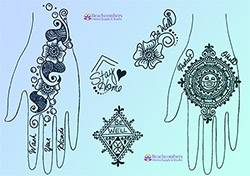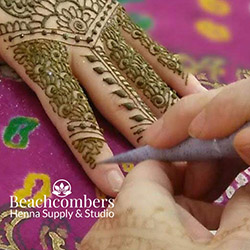Covid-19 Henna Safety Practices It is a difficult time to be a henna artist. Do you open up? Do you stay closed? If you open, what does that look like? It is a difficult time to be a henna artist. Do you open up? Do you stay closed? If you open, what does that look like?
These questions depend on a number of factors and only you can answer them. Are you in a Covid-19 hotspot? Are your local hospitals in a position to handle an outbreak right now? Are you in an at-risk group for Covid complications?
Is someone in your household at risk? Are you and your household vaccinated? Are your clients likely to follow your rules? Are there people willing to get henna from you? Do you have another source of income?
Do NOT be pressured! This is literally life and death, so take all the time you need to make a decision that works for you.
Once you have decided it is safe to open up and do henna, these ideas can help keep you and your clients safe.
You deserve to be and to feel safe. You are empowered to set boundaries that protect both you and your clients.
Let me say that again. You deserve to be and to feel safe. You are empowered to
set boundaries that protect both you and your clients.
 As henna artists, we have a responsibility to protect our clients. In the past,
that has meant using safe product and good hygiene practices. Today that also means protecting ourselves and our clients from a disease that is still dangerous. As henna artists, we have a responsibility to protect our clients. In the past,
that has meant using safe product and good hygiene practices. Today that also means protecting ourselves and our clients from a disease that is still dangerous.
We have an obligation to slow the spread of the virus so that variants, resistant to the vaccine, do not develop. By using responsible practices, we can help protect our communities. It is YOUR responsibility to keep your clients safe.
The goal is to avoid transmission due to droplets. These droplets don’t just spread during sneezes and coughs. Every breath you expel and every word you speak expels droplets. Those droplets can then be spread either by breathing them in or by touching a surface with contaminated droplets then touching your face.
Much like cars have both seatbelts AND airbags, layered protection is the best
protection for you and your clients, so use as many layers of protections as
possible.
General Safety Practices
- Wear a mask and face shield.
If you have access to an N95 mask, this protects BOTH you and your client.
If you do not have access to an N95 mask, be aware that you are giving your
client a level of protection, but your own protection is limited. Wear
a face shield as well, especially if you are in a group setting. Always bring some extra masks in case your mask or a client's mask breaks. It's worth your time and money to find the most comfortable protective mask that works for you.
I don't know about you, but I didn't get so much as a sniffle this past year. I'm going to continue wearing masks for all my group events and after the danger of Covid has passed.
- Require clients to wear masks or face coverings.
If they don’t want to wear a mask, you have every right to refuse service.
Consider offering some masks for sale (either disposable or not) so you
don’t have to turn clients away. Create “masks required” signage.
- Ensure your set-up is comprised of easily sanitized items.
No fabric chairs or tablecloths. Instead of a fabric table covering, use
either a wipe-able outdoor-style tablecloth or use a transparent table
covering over fabric. A clear shower curtain works well. If you use
toothpicks or cuticle sticks to remove mistakes, these are disposable items.
They cannot be sanitized and thus should be disposed of once used. Henna
cone tips should be wiped with alcohol between clients or make tiny little
individual cones for each client.
- No more design books.
Our lovely henna designs books that we’ve worked so hard to build are now a
potential liability. Change to some sort of vertical display of henna
designs that do not require people to touch them.
- Avoid enclosed spaces.
When possible, henna in outdoor or well ventilated spaces. Avoid small rooms without air circulation. Set up a fan to push air away from yourself and your client.
- Collect contact-tracing information.
If you or one of your clients contracts the Coronavirus, you will need the
contact information of everyone you’ve been in contact with, including
clients. This information should be kept completely private and should be
eliminated after 30 days (or whatever local regulations determine).
Encourage clients to get henna on their forearm, foot, or calf instead of their hands. Since we are washing and using hand sanitizer so often, henna stains on the hands are fading 50-70% faster than normal. Forearm henna doesn’t get as dark as hand henna, but it will last SUBSTANTIALLY longer.
Private Henna AppointmentsIf private appointments are scheduled at your own studio, you have control
over your environment. Take advantage of that to create the safest space
possible. If you are meeting somewhere, consider what kinds of
precautions/controls you are able to ensure.
- Wash your hands.
Require that BOTH you and your client wash your hands for at least 20
seconds using soap and water. If you are lucky enough to be in a situation
where this is possible, be diligent about it. Add signage near the sink with proper hand-washing technique.
*Remember hand sanitizer can interfere with henna stains, so don’t use hand
sanitizer on clients. Washing hands and rubbing alcohol are better options.*
- Set up a barrier, when possible.
The Plexiglas dividers that are used in nail salons are ideal. They have a
space where the client can slip their arm through. Depending on what part of
the body you are hennaing, this may not be possible, but use it when you
can.
- Prop feet away from client.
Remember, droplets go down not up. If you are below your client, you are at
substantially higher risk of droplets contacting your face. Try to prop the feet in a way that you are not
directly below the client’s face. Think of how far away from a client’s face
a pedicurist is sitting and aim for that. Be sure the client’s mask is on properly. If you don’t have a face shield, wear a hat or visor.
- Sanitize the entire area between clients.
Be diligent and sanitize all touch-surfaces and anywhere droplets may have
landed, between EACH client.
- Wash your hands again when you finish.
After you sanitize the entire area, wash your hands again and apply lotion
(you’ll need it!). Don’t allow your hands to get dry enough to crack.
Group Henna Events
Group events add an additional layer of risk. We don’t want to be responsible for starting an outbreak that hurts someone. We can’t control everything, but we can add as many safety precautions as possible.
It is our responsibility to keep our
clients safe.
Layer those protections!
Modify your contract to include all necessary changes. Speak with the event
organizer about all concerns and check to see if they are keeping a
contact-tracing list.
- Wash your hands.
Before starting your event, wash your hands for 20 seconds with soap and
water.
- Have clients wash hands, if possible.
If it’s a small private party, require clients wash hands before getting henna. this will yield a better stain anyway so woo hoo for hand washing!
- Have clients use an individual alcohol wipe on both hands.
If you are in a setting where clients can’t wash their hands, provide individual alcohol wipes for clients to use before sitting down. Create
signage so that clients have already used these wipes before getting to you, to speed up your line.
*Remember hand sanitizer can interfere with henna stains, so don’t use hand sanitizer on clients. Washing hands and rubbing alcohol are better options.*
- Set up a barrier between you and clients when possible.
The Plexiglas dividers that are used in nail salons are ideal. They have a
space where the client can slip their arm through. They make smaller ones
that are portable.
- Sanitize everything possible between clients.
If you don’t have the time to wipe down the table between clients, use
something disposable such as paper towels, sheets of paper, or disposable placemats
that can be changed between each client. Use hand sanitizer on yourself. For
gloves to be effective, they must be changed between every client. Hand
sanitizer is just as effective with far less waste.
- Manage lines for social distancing.
Do whatever works best for your needs and event. Create signage that
encourages physical distancing. Use painters tape and mark 6' distances in your line. Small cones that are used for sports can also be used for line control. Pennant banners can easily be strung up and you can get them in
your brand colors at nearly any party store.
- Remember to wash your hands again when you finish.
After you sanitize the area and pack up, wash your hands again and apply
lotion (you’ll need it!). Do not allow your hands to get dry enough to
crack.
Potential Supply ListIn addition to your typical henna supplies, some of these supplies may be helpful.
- Individual alcohol swabs
- Disposable masks (always have extra in case yours or a clients mask breaks)
- Face shield
- Disposable placemats
- Wipeable table cover
- Cuticle sticks/cut straws (disposable)
- Plexiglas divider and cleaner
- Hand sanitizer for you
- Floor cones/painters' tape/pennant banners
- Signage
- Masks required
- Proper hand-washing
- Stop germs signage
- Physical distancing reminders
- Line control signage
|